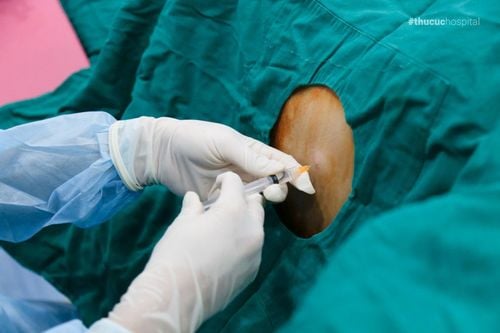This is an automatically translated article.
The article was professionally consulted by Specialist Doctor II Pham Thi Tuyet Mai - Obstetrician and Gynecologist - Department of Obstetrics and Gynecology, Vinmec Hai Phong International General HospitalMany studies show that pelvic floor disorders are not life-threatening but greatly affect the patient's quality of life, causing disorders in many organ systems: urinary and bowel incontinence, obstruction of the urinary tract. lower urinary tract, constipation, pelvic discomfort, recurrent urinary tract infections and sexual dysfunction such as pain during intercourse
1. What is the pelvic floor?
The pelvic floor is like a hammock made up of many interlocking weights and muscles. This fascia and pelvic floor muscle is firmly attached to the front of the abdomen and pubic bone, the two sides are the hip bones, and the back is the lumbar spine down to the sacrum.
The pelvic floor is the totality of 3 systems: the genitourinary system (uterus, vagina), the lower urinary system (bladder, urethra) and the lower digestive system (rectum, anus). The pelvic floor also contains many vascular and nervous systems.
The job of the pelvic floor is to keep these organs in place, not to fall down when doing heavy work, running and jumping.
The pelvic floor also plays the role of opening and closing the openings of the urinary tract, vagina, anus, helping to control bowel movements and urination at will, sexual activity, making the birth process easier. These three systems work in harmony with each other, each supporting the other under the active control of humans.
2. What is pelvic floor dysfunction?
Experiencing pregnancy or due to age factors, a woman's pelvic floor muscles and ligaments are aging and stretched, so they are no longer able to keep the pelvic organs in their original position. This is called pelvic floor dysfunction.
According to statistics, 1 out of 3 women who have ever been pregnant and given birth will experience urinary incontinence after giving birth. Nearly 50% of women over 40 years old have urinary incontinence, 40% of women over 50 years old have pelvic organ prolapse, of which 1 in 5 people have 2 or more organs prolapse (uterine prolapse, prolapsed uterus). bladder prolapse, rectal prolapse).
3. Symptoms of pelvic floor dysfunction

In the early stages, the patient will see a bulge in the vulva area when squatting, coughing or straining to have a bowel movement. In addition to early manifestations, pelvic floor dysfunction also has the following manifestations:
Urinary tract: Urinary incontinence when coughing, running or carrying heavy objects; Not being able to hold the urine at will when urinating; Nocturia more than 1 time; Increased or decreased feeling of needing to urinate, urinary frequency more than 8 times/day; Difficulty urinating or straining; There is a feeling of not passing urine. Having a bowel movement: Having a feeling of gas, leaking stools when coughing, sneezing or running; Unable to keep up when gasping or having a bowel movement; Prolonged constipation, difficult bowel movements, need to use pump or oral medicine to digest. Genital tract: Uterine prolapse; Bladder prolapse; Rectal prolapse, bowel. Sexual life disorders: Pain during sex; Decreased feelings of desire; The door feels wide. Chronic pelvic pain: Pelvic back pain; Pain in the lower abdomen or in the portal area.
4. Who is prone to pelvic floor dysfunction?
Pelvic floor muscles will weaken with age, with the number of pregnancies and births as well as trauma during the reproductive process; Endocrine deficiency in postmenopausal women; Factors that cause chronic increase in intra-abdominal pressure include: obesity, chronic cough, chronic constipation, repetitive heavy lifting.
5. Treatment of pelvic floor dysfunction
Treatment for pelvic floor dysfunction depends on the extent of pelvic floor dysfunction and the individual circumstances of the patient. Including the following basic methods:Change living habits: Eat a lot of fiber-rich foods, vegetables, drink 1.5 liters of water/day, control weight and have weight loss methods;

Exercise pelvic floor exercises: Helps prevent and effectively treat 80% of urinary incontinence, gas leakage, fecal incontinence, urinary incontinence, urinary incontinence, nocturia; prevent prolapse of organs in the pelvis, including: prolapse of the uterus, bladder, and rectum; prevention and treatment of urinary incontinence, dysuria, and fecal incontinence for pregnant and postpartum women; assist in easier labor; improve, increase sexual sensation in both women and men; Exercise pelvic floor muscles with a machine: Including an ultrasound machine, an exercise guide or an electromechanical stimulator to identify muscle groups to exercise. Exercise bowel and bladder physiotherapy: To help control urination and bowel movements; Drug treatment: In case of vaginal infection or malnourishment; Using Pessary lifting ring: Use under the advice of a doctor to treat pelvic organ prolapse, urinary incontinence; Surgery: Indicated by a doctor when medical treatments do not bring results. Although not directly threatening the patient's life, pelvic floor dysfunction significantly affects the patient's quality of life, making the patient feel ashamed and unconfident.
Due to the shy mentality of carrying a "difficult disease" and seeing it as not life-threatening, many women do not go for treatment, so that the condition of the disease gets worse and leads to complications. Therefore, when you yourself or a loved one have problems with suspected pelvic floor dysfunction, go to specialized medical facilities for timely diagnosis and treatment.
Please dial HOTLINE for more information or register for an appointment HERE. Download MyVinmec app to make appointments faster and to manage your bookings easily.














